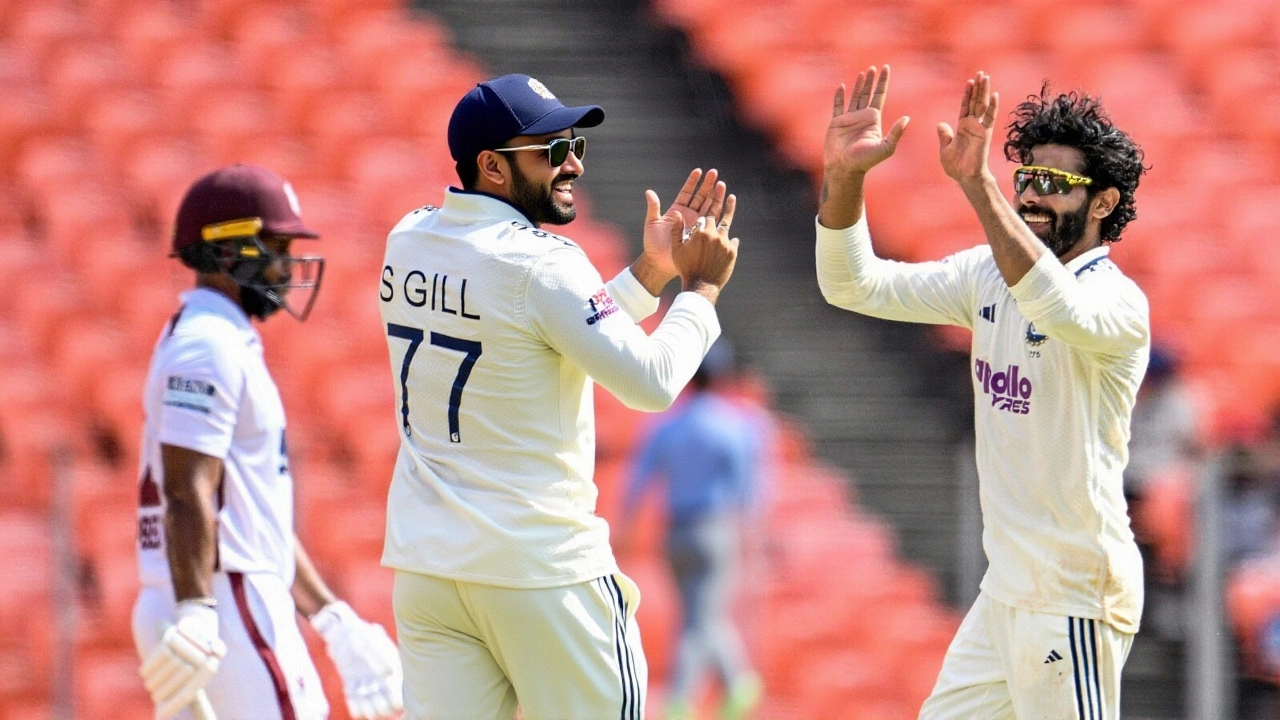When KL Rahul reached his hundred at the Ahmedabad ground, the result was obvious: India had taken a massive 286‑run command after just two days.
Day two in a nutshell
During 1st Test, India vs West IndiesAhmedabad, the home side piled on 448 for five at stumps, up from 218/3 at lunch. The bulk of the scoreboard came from the middle and lower order, a rarity that left the West Indies bowlers scratching their heads.
Centuries from the unexpected order
Dhruv Jurel played the innings of a lifetime, smashing 125 with a mix of crisp drives and late‑cut brilliance. One particular delivery saw him shift his weight onto the back foot, guide the ball through point and send it racing past the fielder at backward point – a textbook example of timing and placement.
Not to be outdone, Ravindra Jadeja counter‑attacked with an unbeaten 112. Eleven fours and six sixes later, his third six was a flamboyant leap down the pitch, lofting a ball over long‑on off Warrican's left‑arm spin. Jadeja’s aggression turned the innings into a statement of intent.
Meanwhile, KL Rahul remained unflustered, cruising to an unbeaten century that anchored the top order. His calmness under pressure gave the younger batsmen the freedom to play their natural game.
West Indies fight back – or not
The West Indies attack, spearheaded by Justin Greaves, could barely contain the flow of runs. Greaves’ length and bounce were rendered ineffective as the Indians compiled boundaries at will.
In the second innings, opener Tejan Chandrapaul was caught for a duck on the second ball of the 120th over, clean bowled by Jasprit Bumrah. Bumrah’s outswinger rattled the top order, leaving the West Indies at 0/1 and the scoreboard staring at another looming deficit.
Veteran Shai Hope also fell early, dismissed for just one run off 14 balls. Jadeja claimed his wicket with a keen length that caught Hope on an attempted width‑offered delivery.
Even with contributions from John Campbell and Brandon King, the West Indies were 46 for five in their first innings and trailed by 240 runs.
Key bowling performances
Mohammed Siraj provided the seam support, earning the wicket of Shai Hope and maintaining pressure with his sharp yorkers. Yashasvi Jaiswal added a spectacular diving catch at backward point, showcasing India’s fielding edge.
Fielding brilliance also came from Nitish Kumar Reddy, who dived to stop a reverse‑sweep attempt from Alick Athanaze, and Axar Patel, who was spotted handing drinks to the set batsmen during the long innings.
Implications for the series
With a 286‑run cushion, the series now leans heavily in India’s favor. The psychological edge of three centuries – something West Indies haven’t seen from a single side in a Test in decades – will be hard to erase.
West Indies will need to regroup quickly, perhaps tweaking their pace attack to extract more bounce on the slower tracks of Gujarat. The next two days will test their resilience and whether their batting depth can survive India’s relentless assault.
Key facts
- India’s first‑innings total: 459 all out.
- Centuries: KL Rahul 100*; Dhruv Jurel 125; Ravindra Jadeja 112*.
- Lead at stumps: 286 runs.
- West Indies 1st‑innings score: 219 all out.
- Key bowlers: Jasprit Bumrah (2/42), Mohammed Siraj (3/58), Ravindra Jadeja (3/45).
Frequently Asked Questions
How does the 286‑run lead affect West Indies' chances of winning?
A lead of that size after just two days puts immense pressure on the touring side. West Indies must score quickly in their second innings and then bowl out India before the remaining time runs out – a tall order given India’s current batting form and bowling firepower.
What were the decisive moments in India’s innings?
The partnership between Jurel and Jadeja shifted momentum, turning a solid platform into a runaway total. Rahul’s unbeaten century steadied the top order, while Bumrah’s early breakthrough in the West Indies second innings kept the pressure ticking.
Who were the standout bowlers for India?
Jasprit Bumrah’s outswinger claimed the crucial wicket of Chandrapaul for a duck, and his disciplined line forced several false shots. Ravindra Jadeja added three wickets with his left‑arm spin, while Mohammed Siraj kept the end‑line tight, taking three catches and two key wickets.
What adjustments can West Indies make to stay competitive?
They need to tighten their line and length, especially on the middle and lower order. Using short-pitched deliveries to exploit any bounce, and rotating the strike early to build partnerships, could chip away at the massive deficit.
When is the next Test match in the series?
The second Test is scheduled for July 9‑13 at the Wankhede Stadium in Mumbai. With the series now heavily tilted toward India, the upcoming match will be a crucial chance for West Indies to claw back momentum.
